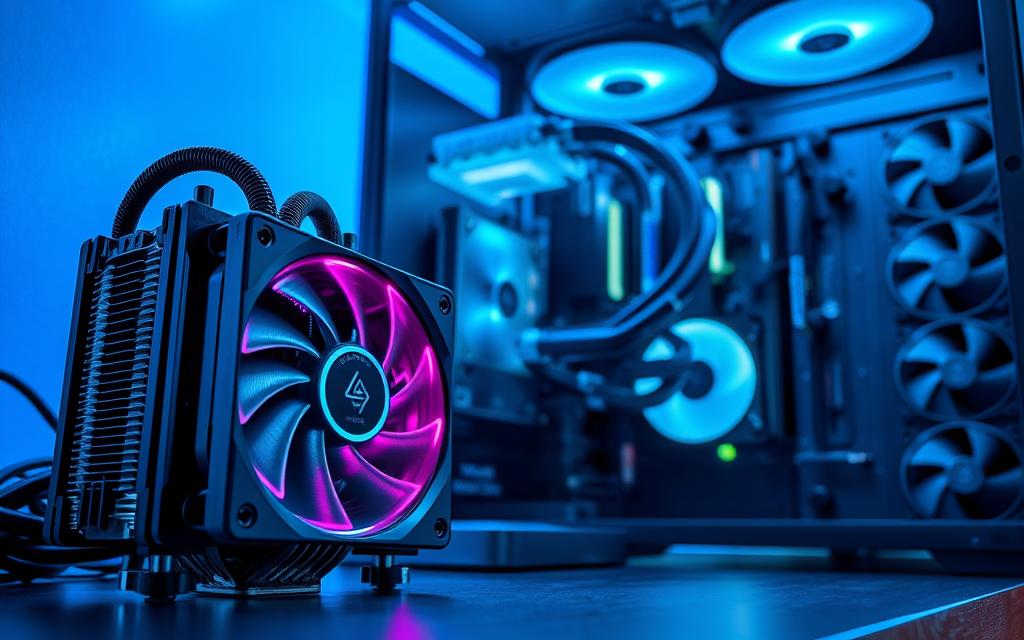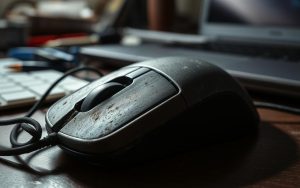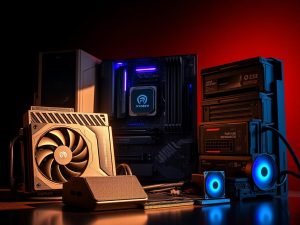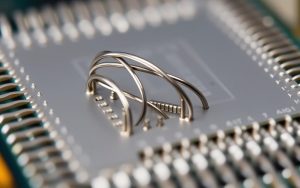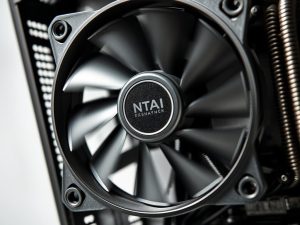Table of Contents
Proper thermal management is crucial for maintaining your computer’s performance and longevity. Whether you’re a casual user or a hardcore gamer, overheating can lead to serious issues like hardware damage and reduced lifespan.
Sustained high temperatures can cause your system to throttle, slowing down tasks and making it less efficient. This is especially problematic for demanding applications like gaming or video editing, where consistent power is essential.
This guide explores practical ways to keep your computer running smoothly. From immediate fixes to advanced cooling solutions, you’ll find actionable tips to prevent overheating and extend your hardware’s life.
By addressing thermal issues early, you can avoid costly replacements and ensure your system operates at peak performance. Let’s dive into effective strategies to maintain optimal temperatures and protect your investment.
Why Your PC Overheats and How to Spot the Signs
Understanding the root causes of overheating can save your computer from permanent damage. Excessive heat can harm internal components, leading to reduced performance and even hardware failure. Recognizing the signs early is crucial to addressing the problem before it escalates.
Common Causes of Overheating
Dust accumulation is a major culprit, accounting for 73% of overheating cases. When dust clogs vents and fans, it restricts airflow, causing temperatures to rise. Another common issue is placing your laptop in direct sunlight, which can increase internal temperature by 10-15°F.
High CPU and GPU usage also contribute to overheating. Applications like Adobe Premiere Pro can spike temperature to 82°C during rendering. Even browser tabs can add to the load, with each Chrome tab consuming 100-200MB of RAM.
Warning Signs Your PC Is Running Too Hot
Your laptop or desktop may show clear signs of overheating. Error messages like “CPU over-temperature error” or BSOD codes 124/129 are red flags. Performance drops, especially when temperature exceeds 90°C, indicate a serious issue.
Unusual fan noise or frequent system crashes are also common symptoms. Monitoring software like Core Temp can help you track real-time temperature changes and take action before damage occurs.
By addressing these causes and recognizing the warning signs, you can protect your laptop or desktop from overheating. Regular maintenance and monitoring are key to ensuring your system runs smoothly.
How to Cool Down My PC: Immediate Fixes
Quick fixes can significantly reduce your system’s temperature. Overheating often stems from poor airflow or excessive resource usage. Addressing these issues promptly can restore performance and prevent long-term damage.
Reposition Your Device for Better Airflow
Proper placement is crucial for maintaining optimal temperatures. For desktops, ensure at least 2-3 inches of space around vents. Elevating the base can also improve airflow.
For laptops, place them on hard, flat surfaces. Soft materials like beds or couches block vents, increasing the risk of overheating. A cooling pad can further enhance airflow and reduce temperatures by 7-10°C.
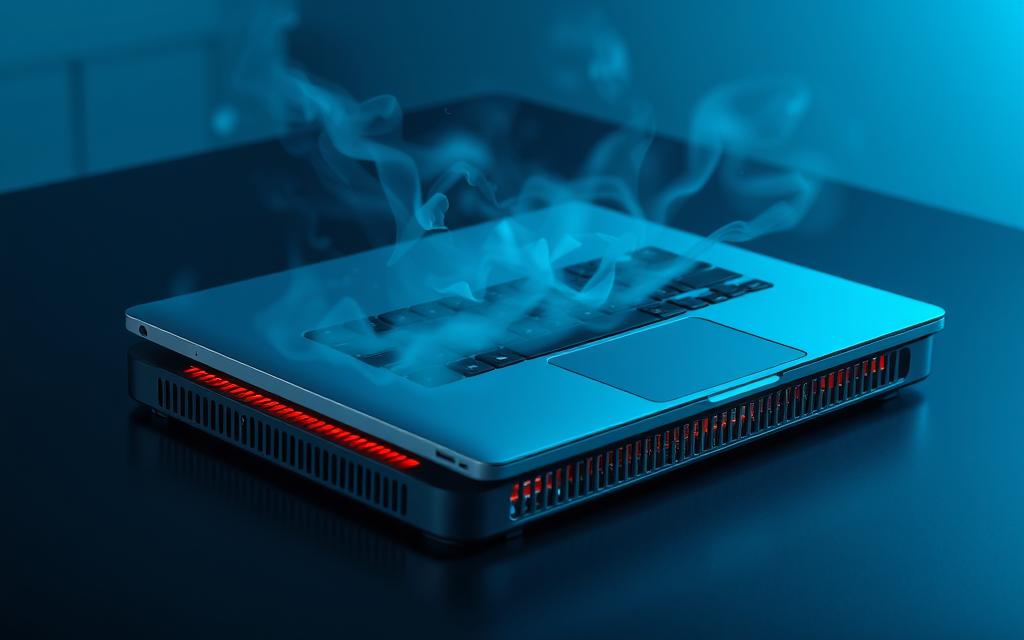
Close Unresponsive Programs and Browser Tabs
Resource-heavy applications and multiple browser tabs can strain your system. Use Windows Task Manager (Ctrl+Shift+Esc) to identify and terminate unresponsive processes.
Closing 10 Chrome tabs can reduce CPU load by 18%. Tools like Avast Secure Browser offer tab freezing features to save resources. Regularly monitor your system’s performance to avoid this problem.
By implementing these quick fixes, you can maintain a way cool system and ensure it runs efficiently.
Optimize Your PC’s Hardware for Better Cooling
Effective cooling starts with optimizing your PC’s internal components. Proper hardware adjustments can prevent overheating and enhance performance. From cleaning dust to upgrading fans, these steps ensure your system runs efficiently.
Clean Dust from Fans and Vents
Dust accumulation is a common issue that restricts airflow and increases temperatures. Regularly cleaning your fans and vents can improve airflow by 15-20%. Use canned air or an anti-static brush to remove dust from GPU and CPU fans.
For best results, clean your system every 3-6 months. This simple step can reduce temperatures by up to 12°C, protecting your components from heat-related damage.
Upgrade Your CPU Fan for Higher Efficiency
Stock CPU fans often struggle to handle high workloads. Upgrading to a high-performance fan like the Noctua NH-D15 can improve cooling efficiency by 25%. Air coolers like the be quiet! Dark Rock 4 are also excellent alternatives.
When choosing a fan, consider CFM ratings. For example, the 120mm Arctic P12 moves 56.3 CFM, ensuring optimal airflow for your case.
Install Case Fans for Balanced Airflow
Proper airflow is essential for maintaining low temperatures. Installing additional case fans can create a balanced cooling system. Positive pressure setups, where intake fans outnumber exhaust fans, reduce dust accumulation by up to 40%.
Ensure fan sizes match to avoid negative pressure, which can disrupt airflow. Tools like a thermal camera can help you monitor temperature changes and optimize fan placement.
Check Your Power Supply Fan’s Functionality
The power supply fan plays a crucial role in cooling your system. A malfunctioning PSU fan can reduce cooling efficiency by up to 15%. Regularly test your PSU fan to ensure it’s working correctly.
For detailed guidance on fan configurations, visit this resource. Proper maintenance and upgrades can save you from costly replacements and keep your systems running smoothly.
Adjust Software and Settings to Reduce Heat
Optimizing your system’s software and settings can significantly reduce heat buildup. Simple adjustments to your operating system, display, and background processes can improve performance and lower temperatures. Let’s explore practical steps to keep your system running efficiently.
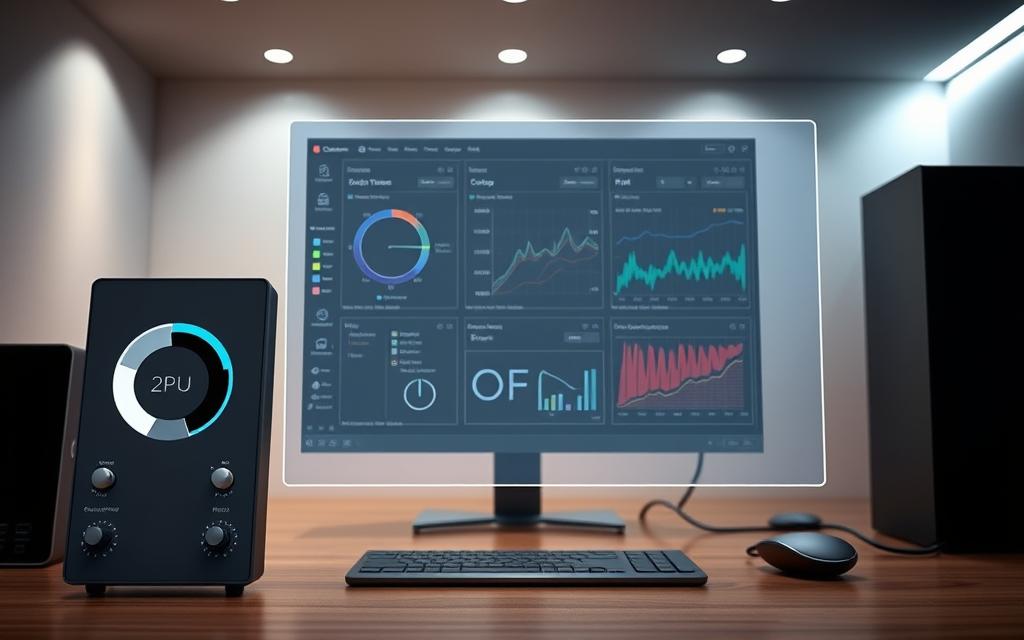
Update Your OS and Drivers
Keeping your Windows operating system and drivers up to date is essential. For example, Windows 11 reduces CPU load by 15% compared to Windows 10. Regular updates improve efficiency by 30%, ensuring your processor and graphics card operate smoothly.
Use Windows Update for Business to automate the process. This ensures your system always runs the latest software, minimizing heat-related issues.
Lower Screen Brightness and Resolution
High screen brightness and resolution can strain your graphics card. For instance, 4K resolution increases GPU temperature by 22°F. Lowering these settings can reduce the load on your hardware.
Benchmarks show that switching from 1440p to 1080p in games like Cyberpunk 2077 can lower temperatures by 10-15°F. Adjusting these settings is a quick way to improve performance and reduce heat.
Manage Background Processes with Task Manager
Unnecessary background processes consume resources and increase heat. Use Windows Task Manager (Ctrl+Shift+Esc) to identify and terminate bloatware. Tools like Avast Secure Browser can freeze unused tabs, saving power and reducing CPU load.
Creating custom power plans, such as Balanced or Power Saver, can also help. These plans optimize resources, ensuring your system runs efficiently without overheating.
Routine Maintenance to Prevent Overheating
Consistent maintenance is key to keeping your system running smoothly. Over time, dust and wear can affect your components, leading to overheating and potential damage. Regular upkeep ensures your hardware stays in top condition.
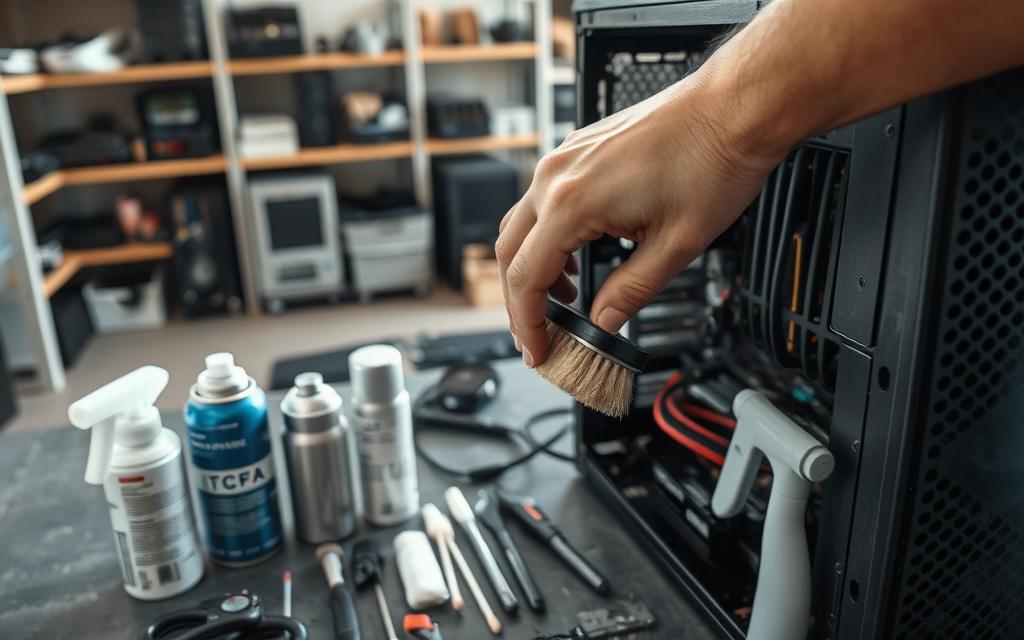
Deep-Clean Your PC Every 3-6 Months
Dust buildup is one of the most common causes of overheating. Cleaning your system every 3-6 months can prevent 92% of dust-related failures. Use compressed air to remove dust from components like fans, vents, and heat sinks.
Make sure to power down your laptop or desktop before cleaning. Use an ESD wrist strap to avoid static discharge, which can harm sensitive parts. For thorough cleaning, consider using tools like Kimwipes and 99% isopropyl alcohol.
Reapply Thermal Paste to CPU/GPU
Thermal paste ensures efficient heat transfer between your CPU/GPU and their coolers. Over time, it can degrade, leading to higher temperatures. Reapplying thermal paste can reduce temps by up to 8°C, as seen with Thermal Grizzly Kryonaut.
When reapplying, clean the old paste with isopropyl alcohol. Apply a small amount in an X-pattern or dot method for even coverage. This simple step can significantly improve your system’s cooling performance.
For more tips on maintaining your laptop or desktop, check out this resource. Regular maintenance not only prevents overheating but also enhances your overall experience with your device.
Advanced Cooling Solutions for High-Performance PCs
High-performance PCs demand advanced cooling solutions to handle intense workloads. Whether you’re pushing your cpu to its limits or running graphics-heavy tasks, effective cooling ensures stability and longevity.
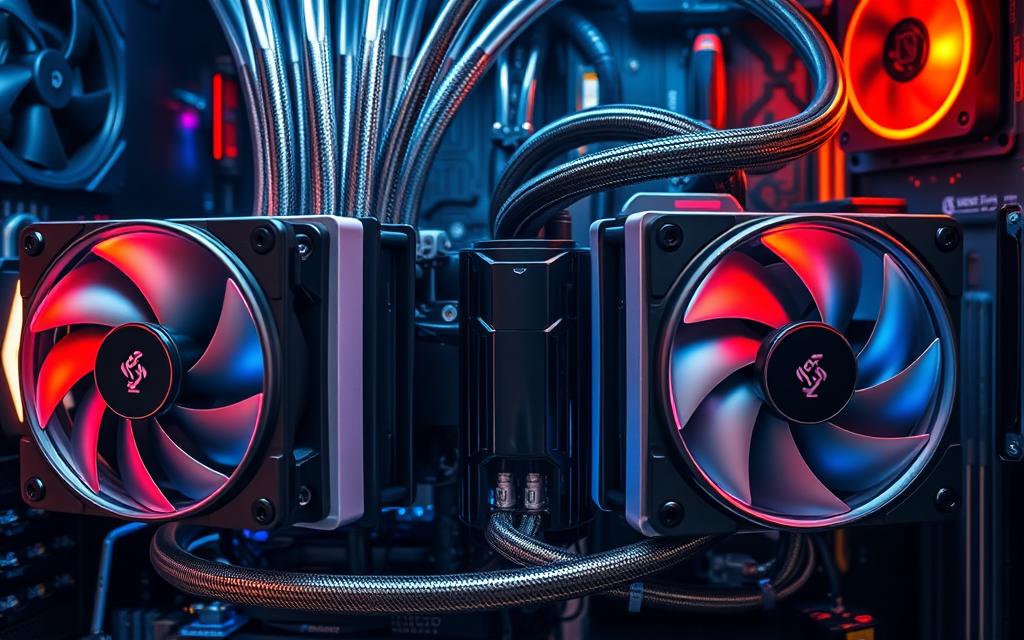
Water-Cooling Kits for Gaming Rigs
Water-cooling is a game-changer for gaming rigs. Custom loops outperform AIO coolers by up to 40%, offering superior heat dissipation. Popular options like the NZXT Kraken Z73 and Corsair iCUE H150i Elite Capellix provide excellent performance.
When choosing a water-cooling kit, consider loop configurations. Parallel loops split coolant flow for balanced cooling, while series loops ensure uniform heat transfer. Hybrid setups combine both for optimal results.
GPU Optimization for Graphics-Heavy Tasks
Undervolting your GPU can reduce heat without sacrificing performance. Tools like MSI Afterburner allow precise adjustments, lowering temperatures by up to 18°C. Test stability using benchmarks like Heaven Benchmark for reliable results.
For advanced setups, EK Quantum Vector blocks are compatible with most modern GPUs. These blocks enhance both aesthetics and cooling efficiency, making them ideal for high-end systems.
By implementing these advanced solutions, you can keep your cpu and GPU running efficiently, even under heavy loads.
Conclusion: Keep Your PC Running Cool and Efficiently
Maintaining optimal temperatures ensures your computer runs smoothly and efficiently. By adhering to critical thresholds like a 176°F CPU max and cleaning cycles every three months, you can prevent overheating and extend your system’s lifespan.
Regular maintenance offers long-term benefits, saving you time and money. Avoid quick-fix myths like using ice packs or freezers, as these can cause irreversible damage. Instead, rely on trusted ways to manage heat, such as cleaning vents and upgrading fans.
For advanced solutions, explore manufacturer resources like Intel ARK and AMD Wattman. Stay informed about emerging cooling technologies, such as phase-change and immersion systems, to future-proof your setup.
Download a maintenance calendar template to stay on track. With these results-driven strategies, you can ensure your computer performs at its best for years to come.
FAQ
What are the common causes of PC overheating?
Overheating often results from blocked vents, dust buildup, outdated drivers, or excessive background processes. High-performance tasks like gaming or video editing can also strain components.
How can I spot signs of overheating in my computer?
Warning signs include loud fan noise, frequent crashes, slow performance, or the system shutting down unexpectedly. Hot air blowing from vents is another clear indicator.
What immediate steps can I take to cool down my PC?
Reposition your computer to improve airflow and shut down unresponsive programs or browser tabs. Ensure vents are unobstructed for proper ventilation.
How can I optimize my PC’s hardware for better cooling?
Clean dust from fans and vents, upgrade your CPU fan, install additional case fans, and check the functionality of your power supply fan.
What software adjustments can reduce heat generation?
Update your operating system and drivers, lower screen brightness and resolution, and manage background processes using Task Manager to reduce system strain.
How often should I perform routine maintenance to prevent overheating?
Deep-clean your PC every 3-6 months and reapply thermal paste to the CPU and GPU to ensure efficient heat transfer.
What advanced cooling solutions are available for high-performance PCs?
Water-cooling kits are ideal for gaming rigs, while GPU optimization helps manage heat during graphics-heavy tasks like rendering or streaming.


